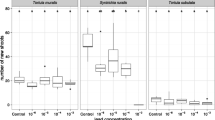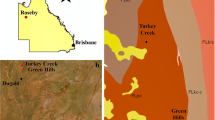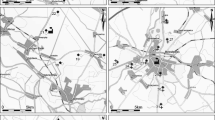Abstract
We present a case study on the tissue absorption of copper of a widely distributed moss species, Ptychostomum capillare in the polluted soil of an abandoned copper mine in central Spain. We studied the soil properties in a copper soil pollution gradient and sampled the moss tufts growing on them in four plots with contrasted soil copper levels. We determined the copper content in the soil and in the moss tissues. On these moss samples, we also performed histochemical tests and X-ray dispersive spectrometry coupled with scanning electron microscopy (SEM-EDX), both in untreated shoots and in samples where surface waxes were removed. We checked the behavior of this species using a metallophillous moss, Scopelophila cataractae, for comparative purposes. Copper contents in P. capillare seem to depend more on available, rather than total soil copper contents. Our results indicate that this moss is able to concentrate 12-fold the available soil copper in soil with low available copper content, whereas in the most polluted soil the concentration of Cu in the moss was only half those levels. Both histochemical and SEM-EDX tests show no surface copper in the mosses from the least polluted plot, whereas in samples from the soil with highest copper content, the removal of surface waxes also reduces or removes copper from the moss shoots. Our observations point at a mixed strategy in P. capillare in this copper mine, with metal accumulation behavior in the lowest Cu plot, and an exclusion mechanism involving wax-like substances acting as a barrier in the most polluted plots. These distortions impede the estimation of environmental levels and thus compromise the value of this moss in biomonitoring. We highlight the need of extending these studies to other moss species, especially those used in biomonitoring programs.





Similar content being viewed by others
References
Aboal JR, Fernández JA, Boquete T, Carballeira A (2010) Is it possible to estimate atmospheric deposition of heavy metals by analysis of terrestrial mosses? Sci Total Environ 408(24):6291–6297. https://doi.org/10.1016/j.scitotenv.2010.09.013
Aboal JR, Boquete MT, Carballeira A, Casanova A, Debén S, Fernández JA (2017) Quantification of the overall measurement uncertainty associated with the passive moss biomonitoring technique: sample collection and processing. Environ Pollut 224:235–242. https://doi.org/10.1016/j.envpol.2017.01.084
Alloway BJ (ed) (2013) Heavy metals in soils: trace metals and metalloids in soils and their bioavailability. Springer, Dordrecht
Bancroft JD, Stevens A (1982) Theory and practice of histological techniques, 2nd edn. Churchill Livingstone, London
BOCM (2006) Order 2770/2006, 11 Aug, Regional Ministry of Environment and Territory of the Government of Madrid, establishing generic reference levels of heavy metals and other trace elements in contaminated soils of the Community of Madrid BOCM 204 (28 Aug 2006), pp 29–30 (in Spanish)
Borkert CM, Cox FR, Tucker MR (1998) Zinc and copper toxicity in peanut, soybean, rice and corn in soil mixtures. Commun Soil Sci Plat Anal 29(192):2991–3005. https://doi.org/10.1080/00103629809370171
Bravo-Gómez ME, Espinoza-Guillén A, Castillo S, Barba N (2015) Metalochaperonas: escoltas personales en el tráfico intracelular de iones metálicos. Educación Química 26(1):26–37. https://doi.org/10.1016/S0187-893X(15)72095-1
Bremner JM, Mulvaney CS (1982) Nitrogen-Total. In: Page AL, Miller RH, Keeney DR (eds) Methods of soil analysis. Part 2. Chemical and microbiological properties. American Society of Agronomy, Soil Science Society of America, Madison, Wisconsin, pp 595–624
Broadhurst CL, Chaney RL, Angle JS, Erbe EF, Maugel TK (2004) Nickel localization and response to increasing Ni soil levels in leaves of the Ni hyperaccumulator Alyssum murale. Plant Soil 265(1):225–242. https://doi.org/10.1007/s11104-005-0974-8
Brown DH, Wells JM (1990) Physiological effects of heavy metals on the moss Rhytidiadelphus squarrosus. Ann Bot 66(6):641–647. https://doi.org/10.1093/oxfordjournals.aob.a088078
Buch H (1945) Über die Wasser- und Mineralstoffversorgung der Moose (I). Comm Biol Soc Sci Fenn 9(16):1–44
Chardonnens AN, Wilma M, Vellinga S, Schat H, Verkleij JA, Ernst WH (1999) Allocation patterns of zinc and cadmium in heavy metal tolerant and sensitive Silene vulgaris. J Plant Physiol 155(6):778–787. https://doi.org/10.1016/S0176-1617(99)80096-0
Chen H, Teng Y, Lu S, Wang Y, Wang J (2015) Contamination features and health risk of soil heavy metals in China. Sci Total Environ 512:143–153. https://doi.org/10.1016/j.scitotenv.2015.01.025
Cheng S (2003) Effects of heavy metals on plants and resistance mechanisms. Environ Sci Pollut Res 10(4):256–264. https://doi.org/10.1065/espr2002.11.141.2
Chettri MK, Sawidis T, Zachariadis GA, Stratis JA (1997) Uptake of heavy metals by living and dead Cladonia thalli. Environ Exp Bot 37(1):39–52. https://doi.org/10.1016/S0098-8472(96)01023-4
Cogolludo J, Estébanez B, Medina NG (2017) The effects of experimentally supplied lead nitrate on three common Mediterranean moss species. Environ Sci Pollut Res 24:26194–26205. https://doi.org/10.1007/s11356-017-9220-1
Colzi I, Pignattelli S, Giorni E, Papini A, Gonnelli C (2015) Linking root traits to copper exclusion mechanisms in Silene paradoxa L. (Caryophyllaceae). Plant Soil 390:1–15. https://doi.org/10.1007/s11104-014-2375-3
Cooke JA, Johnson MS (2002) Ecological restoration of land with particular reference to the mining of metals and industrial minerals: a review of theory and practice. Environ Rev 10:41–71. https://doi.org/10.1139/a01-014
Cornu J-Y, Huguenot D, Jezéquel K, Lollier M, Lebau T (2017) Bioremediation of copper-contaminated soils by bacteria. World J Microbiol Biotechnol 33:26. https://doi.org/10.1007/s11274-016-2191-4
Dierßen K (2001) Distribution, ecological amplitude and phytosociological characterization of European bryophytes. Cramer in der Gebr, Berlin
Ernst WH (2006) Evolution of metal tolerance in higher plants. For Snow Landsc Res 80(3):251–274
Gaetke LM, Chow CK (2003) Copper toxicity, oxidative stress, and antioxidant nutrients. Toxicology 189(1):147–163. https://doi.org/10.1016/S0300-483X(03)00159-8
Giller KE, Witter E, Mcgrath SP (1998) Toxicity of heavy metals to microorganisms and microbial processes in agricultural soils: a review. Soil Biol Biochem 30(10–11):1389–1414. https://doi.org/10.1016/S0038-0717(97)00270-8
Glime JM (2015) Water relations: leaf strategies—cuticles and waxes. In: Glime JM (ed) Bryophyte ecology, vol 1: Physiological ecology. Michigan Technological University and the International Association of Bryologists, ebook, Ch. 7–4b
Guschina IA, Harwood JL (2002) Lipid metabolism in the moss Rhytidiadelphus squarrosus (Hedw.) Warnst. from lead-contaminated and non-contaminated populations. J Exp Bot 53(368):455–463. https://doi.org/10.1093/jexbot/53.368.455
Hall JL (2002) Cellular mechanisms for heavy metal detoxification and tolerance. J Exp Bot 53(366):1–11. https://doi.org/10.1093/jexbot/53.366.1
Harmens H, Norris DA, Steinnes E, Kubin E, Piispanen J, Alber R, Aleksiayenak Y, Blum O, Coskun M, Dam M, De Temmerman L, Fernandez JA, Frolova M, Frontasyeva M, Gonzalez-Miqueo L, Grodzinska K, Jeran Z, Korzekwa S, Krmar M, Kvietkus K, Leblond S, Liiv S, Magnusson SH, Mankovska B, Pesch R, Ruhling Ä, Santamaria JM, Schroder W, Spiric Z, Suchara I, Thöni L, Urumov V, Yurukova L, Zechmeister HG (2010) Mosses as biomonitors of atmospheric heavy metal deposition: spatial patterns and temporal trends in Europe. Environ Pollut 158(10):3144–3156. https://doi.org/10.1016/j.envpol.2010.06.039
Harmens H, Norris DA, Sharps K, Mills G, Alber R, Aleksiayenak YB, Cucu-Man SM, Dam M, De Temmerman L, Ene A, Fernández JA, Martínez-Abaigar J, Frontasyeva M, Godzik B, Jeran Z, Lazo P, Leblond S, Liiv S, Magnússon SH, Maňkovská B, Pihl Karlsson G, Piispanen J, Poikolainen J, Santamaria JM, Skudnik M, Spiric Z, Stafilov T, Steinnes E, Stihi C, Suchara I, Thöni L, Todoran R, Yurukova L, Zechmeister HG (2015) Heavy metal and nitrogen concentrations in mosses are declining across Europe whilst some “hotspots” remain in 2010. Environ Pollut 200:93–104. https://doi.org/10.1016/j.envpol.2015.01.036
ISO (1995) Soil quality. Extraction of trace elements soluble in aqua regia. ISO11466. International Organization for Standardization, confirmed in 2016
Izquieta-Rojano S, Elustondo D, Ederra A, Lasheras E, Santamaría C, Santamaría JM (2016) Pleurochaete squarrosa (Brid.) Lindb. as an alternative moss species for biomonitoring surveys of heavy metal, nitrogen deposition and δ 15 N signatures in a Mediterranean area. Ecol Indic 60:1221–1228. https://doi.org/10.1016/j.ecolind.2015.09.023
Jensen WA (1962) Botanical histochemistry. Principles and practice. Freeman, San Francisco
Jordá L (2008) Metal mining in Madrid province: mining heritage and promotion of the underground space. PhD Thesis. Universidad Politécnica de Madrid, Madrid (in Spanish)
Jules ES, Shaw AJ (1994) Adaptation to metal-contaminated soils in populations of the moss, Ceratodon purpureus: vegetative growth and reproductive expression. Am J Bot 81(6):791–797
Kabata-Pendias A, Pendias H (1984) Trace elements in soils and plants. CRC Press, Florida
Konno H, Nakashima S, Katoh K (2010) Metal-tolerant moss Scopelophila cataractae accumulates copper in the cell wall pectin of the protonema. J Plant Physiol 167(5):358–364. https://doi.org/10.1016/j.jplph.2009.09.011
Lepp NW, Salmon D (1999) A field study of the ecotoxicology of copper to bryophytes. Environ Pollut 106(2):153–156. https://doi.org/10.1016/S0269-7491(99)00080-9
Levitt J (1972) Responses of plants to environmental stresses. Academic Press, New York
Mårtensson O, Berggren A (1954) Some notes on the ecology of the “copper mosses”. Oikos 5:99–100
Mehlich A (1984) Mehlich-3 soil test extractant: a modification of Mehlich 2 extractant. Commun Soil Sci Plant Anal 15:1409–1416. https://doi.org/10.1080/00103628409367568
Morse N, Walter MT, Osmond D, Hunt W (2016) Roadside soils show low plant available zinc and copper concentrations. Environ Pollut 209:30–37. https://doi.org/10.1016/j.envpol.2015.11.011
Murphy J, Riley JP (1962) A modified single solution method for the determination of phosphate in natural waters. Anal Chim Acta 27:31–36. https://doi.org/10.1016/S0003-2670(00)88444-5
Nelson DW, Sommers LE (1982) Total carbon, organic carbon and organic matter. In: Page AL, Miller RH, Keeney DR (eds) Methods of soil analysis, part 2: Chemical and microbiological properties. American Society of Agronomy Soil Science Society of America, Madison, pp 539–579
Onianwa PC (2001) Monitoring atmospheric metal pollution: a review of the use of mosses as indicators. Environ Monit Assess 71:13–50
Pais I, Jones B Jr (1997) The handbook of trace elements. St. Lucie Press, Boca Raton
Persson H (1956) Studies in "copper mosses.". J Hattori Bot Lab 17:1–18
Proctor MCF (1979) Surface wax on the leaves of some mosses. J Bryol 10(4):531–538. https://doi.org/10.1179/jbr.1979.10.4.531
Psaras GK, Constantinidis TH, Cotsopoulos B, Manetas Y (2000) Relative abundance of nickel in the leaf epidermis of eight hyperaccumulators: evidence that the metal is excluded from both guard cells and trichomes. Ann Bot 86(1):73–78. https://doi.org/10.1006/anbo.2000.1161
Satake K (2013) The mystery of copper bryophytes (in Japanese). Iseb, Tsukuba
Satake K, Shibata K, Nishikawa M, Fuwa K (1988) Copper accumulation and location in the moss Scopelophila cataractae. J Bryol 15(2):353–376. https://doi.org/10.1179/jbr.1988.15.2.353
Satake K, Mishikawa M, Shibata (1990) A copper-rich protonemaI colony of the moss Scopelophila cataractae. J Bryol 16(1):109–116. https://doi.org/10.1179/jbr.1990.16.1.109
Schröder W, Holy M, Pesch R, Harmens H, Ilyin I, Steinnes E, Alber R, Aleksiayenak Y, Blum O, Coşkun M, Dam M, De Temmerman L, Frolova M, Frontasyeva M, Gonzalez Miqueo L, Grodzińska K, Jeran Z, Korzekwa S, Krmar M, Kubin E, Kvietkus K, Leblond S, Liiv S, Magnússon S, Maňkovská B, Piispanen J, Rühling A, Santamaria J, Spiric Z, Suchara I, Thöni L, Urumov V, Yurukova L, Zechmeister HG (2010) Are cadmium, lead and mercury concentrations in mosses across Europe primarily determined by atmospheric deposition of these metals? J Soils Sediment 10(8):1572–1584. https://doi.org/10.1007/s11368-010-0254-y
Schröder W, Pesch R, Schönrock S, Harmens H, Mills G, Fagerli H (2014) Mapping correlations between nitrogen concentrations in atmospheric deposition and mosses for natural landscapes in Europe. Ecol Indic 36:563–571. https://doi.org/10.1016/j.ecolind.2013.09.013
Schulten A, Krämer U (2017) Interactions between copper homeostasis and metabolism in plants. In: Cánovas F, Lüttge U, Matyssek R (eds) Progress in Botany. Springer, Cham, pp 111–146
Shakya K, Chettri MK, Sawadis T (2008) Impact of heavy metals (copper, zinc, and lead) on the chlorophyll content of some mosses. Arch Environ Contam Toxicol 54(3):412–442. https://doi.org/10.1007/s00244-007-9060-y
Shaw AJ (1993) Population biology of the rare copper moss, Scopelophila cataractae. Am J Bot 80(9):1034–1041
Shaw AJ, Schneider RE (1995) Genetic biogeography of the rare “copper moss”, Mielichhoferia elongata (Bryaceae). Am J Bot 82(1):8–17
Shaw J, Antonovics J, Anderson LE (1987) Inter-and intraspecific variation of mosses in tolerance to copper and zinc. Evolution 41(6):1312–1325
Vukojević V, Sabovljević M, Jovanović S (2005) Mosses accumulate heavy metals from the substrata of coal ash. Arch Biol Sci 57(2):101–106. https://doi.org/10.2298/ABS0502101V
Acknowledgements
The authors want to thank Esperanza Salvador and Enrique Rodríguez (SEM-EDX Laboratory, SIdI, UAM) and Dr. Carlos García-Delgado (AAS Laboratory, Department of Agricultural Chemistry, UAM) for their helpfulness and kind assistance. They also thank three anonymous reviewers for their careful revision and their insights, which have helped significantly to improve the manuscript.
Author information
Authors and Affiliations
Corresponding author
Rights and permissions
About this article
Cite this article
Elvira, N.J., Medina, N.G., Leo, M. et al. Copper Content and Resistance Mechanisms in the Terrestrial Moss Ptychostomum capillare: A Case Study in an Abandoned Copper Mine in Central Spain. Arch Environ Contam Toxicol 79, 49–59 (2020). https://doi.org/10.1007/s00244-020-00739-6
Received:
Accepted:
Published:
Issue Date:
DOI: https://doi.org/10.1007/s00244-020-00739-6




